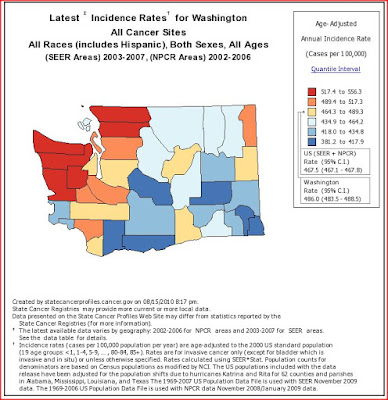In my original post Cancer Rates in Whatcom County, I suggested some environmental sources that might be contributing to Whatcom County's high cancer rates and talked about how those cancer rates have touched our neighborhood quite personally in the last five years. The more I examined the graphic below, however, the more concerned I became that the problem of high cancer rates in Western Washington extends beyond Whatcom County.
This chart, from the NCI's excellent state cancer profiles site, shows an arc of cancer in Western Washington starting in Skagit County (looping over San Juan county) and ending in Gray's Harbor County. All of these counties have incidence rates for all sites of over 517.4 per 100K (e.g. more than 1 in 200) . The only one of these counties that does not border either Puget Sound or the Pacific Ocean is Mason County. Most of these counties are "timber counties" of some historical import. All of them receive substantial rainfall, especially Clallam and Jefferson counties, which may well be among the wettest, darkest counties in the contiguous 48 states.
However this "arc of cancer" may well have something more in common than hard, cold rain. Most observers of the United States military know that the state of Washington is a heavily militarized state. Military facilities of all all branches exist up and down the I-5 corridor, in eastern Washington, and in the south eastern corner of the state we have the Hanford complex - still polluted, still requiring millions of dollars to suppress the leakage of any more radioactive isotopes.
There are two nuclear submarine bases in the United States: King's Bay, Georgia and Bangor-Kitsap, WA. Nuclear submarines are powerful, dangerous creatures armed with a substantial percentage of our nation's nuclear strike force. They are powered by nuclear reactors that use HEU (highly enriched uranium) at a percentage much higher than territorial nuclear power plants. The Navy claims that there has never been a serious nuclear submarine reactor accident in its history. In reality these claims would be difficult to independently verify. (1) No publicly available information exists that monitors the level of anthropogenic or natural radionuclide levels in Puget sound. My local Department of Ecology had no references or information for me when I asked them about such monitoring. Still a look at these recent graphics is enough to generate concern in my mind. (I have added the approximate location of Bangor-Kitsap naval submarine base.):
The right hand graphic is from the NorthWest Training Range Environmental Impact Statement (final) that was released on September 10. This large and comprehensive document details the impact of Naval training and testing particularly in the Olympic National Park MOAs (Military Operation Areas) where the Navy has apparently been firing depleted uranium (DU) shells into the Ocean for some number of years, among the other explosives and hazardous waste their testing may have contributed to the Olympic MOAs. I cannot find any discussion in the Impact Statement that attempts a correlation between NorthWest Washington's high cancer rates and the NorthWest Training Range use of toxic materials. One would think the National Cancer Institute and the Department of Defense might be engaged in joint monitoring of health statistics in regional areas, but I see no evidence of such joint monitoring.
If we are to continue to face high cancer rates in the NorthWest, we need to have frank discussions about the impact that continual or intermittent releases of anthropogenic radionuclides would have on the water cycle, locally grown produce, soil, citizen health etc. This would require a public monitoring program of radiation levels and cancer profiles in the areas most likely affected by such releases.


No comments:
Post a Comment